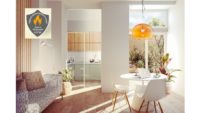Nokia found a single location in the San Francisco Bay Area to consolidate its five Northern California offices. The goal was to create a workplace for the future and center for excellence that would encourage creativity, innovation and collaboration among its employees.
The Nokia R&D Center for Excellence is in a five-story, 156,000-square-foot building in the Sunnyvale Town Center, in Sunnyvale, Calif. The fast-track project was successfully completed to meet the owner’s 14-week construction schedule, under budget. The space is highly secured, technical, flexible, state-of-the-art, energy efficient and seeking LEED Gold certification. San Jose- and San Francisco-based subcontractor California Drywall landed the bid for this important project, which included drywall, metal stud framing and finishing.
Founded in 1946, California Drywall is one of the largest and respected specialty contractors in Northern California.
The company is a full-service commercial specialty contractor whose services include metal stud framing, drywall installation and finishing, lath and plaster, fireproofing and acoustical and specialty ceiling systems.
UNITING DESIGN AND FUNCTIONALITY
There are a few typical wall and ceiling assemblies on the project but many had not been done before, according to California Drywall’s Project Manager Derald Goyette. California Drywall’s bid at the end of the design development phase included engineering details and calculations for the special assemblies. Throughout the project, California Drywall’s engineers, project manager and field personnel worked with the owner, architect and general contractor to ensure these elements were both constructible and economical.
Employees and visitors enter through an airy lobby. Directly off of the lobby, is an open-area housing, multipurpose zone and meeting rooms which can accommodate all-staff training sessions, lectures and events.
The focal point of this area is an origami-like, metal-framed and drywall structure that creates a variety of casual seating zones, including a row of four tables, two meeting nooks, and two conversation pits. The structure “bursts and fragments” into an abstracted tree that rises up 48 feet, through a light well into the second floor, to another key gathering space. Through design and value engineering, California Drywall brought the construction cost for the Tree down by over 50 more than from the design development budget.
Elements of the Tree continue through the building. Stepping off the elevator, people are greeted on each floor by a wall of abstracted tree branches and an instantly identifiable accent color: yellow on two, red on three, green on four, and blue on five.
EMBRACING SHARED WORK SPACES
About 40 percent of the floor plan is dedicated to shared spaces; the other 60 percent of the building is the Flex Zone, an open work station area. Each floor contains the same basic elements-kitchen, centers, centralized communal spaces called Hubs, and two structures dubbed the saunas. At the peripheries, clusters of workstations are arranged into neighborhoods, each associated with a different research group, and each assigned a dedicated conference space and a private phone room, which provide a quiet respite.
While each floor contains the same basic elements, each also has its own attraction: a lounge on the second, arcade games on the third, a Zen space on the fourth and a pool table on the fifth. The first-floor lodge, designed for visiting workers includes Wellness Suites with daybeds and showers.
The Nokia project is a true example of how the changing workplace and economy has evolved into a new expression of design and construction, and a greater collaboration of ideas between an owner, architect, general contractor, and drywall subcontractor which responds to that change. W&C











